Cycling on the moon 🇦🇷 🇨🇱 🇧🇴
I’ve finally reached the end of Argentina and Chile after nearly five and a half months of cycling. The two northernmost provinces of Argentina, Salta and Jujuy were great for cycling. Unfortunately for the people there, they are currently protesting against constitutional reforms and other grievances with the government; the preferred method of protest is road blocks. Eventually, I made it to San Pedro de Atacama in Chile where I was reunited with the Austrian cyclists I had met in Cafayate and I met another cyclist from the UK. Together, the four of us set off for Bolivia and the lagunas route eventually reaching the Salar de Uyuni and the town of Uyuni.
Together with Luca, an Italian cyclist, I set off from Cafayate headed down ruta 68, which promised to be a scenic gentle downhill through a reddish sandstone landscape. We faced quite a strong headwind in the first two or three days, it was a wind that reminded us both of Patagonia having naively thought such gales were firmly behind us. The landscape gave plenty of opportunity to ride out into separate little canyons for further exploration and camping. On the second night out of town we had aimed for a municipal campground that was under construction. Unfortunately, on account of being unfinished we weren’t allowed to stay, but a boat builder let us sleep in his construction site. We fed a dog and it wouldn’t leave us alone.
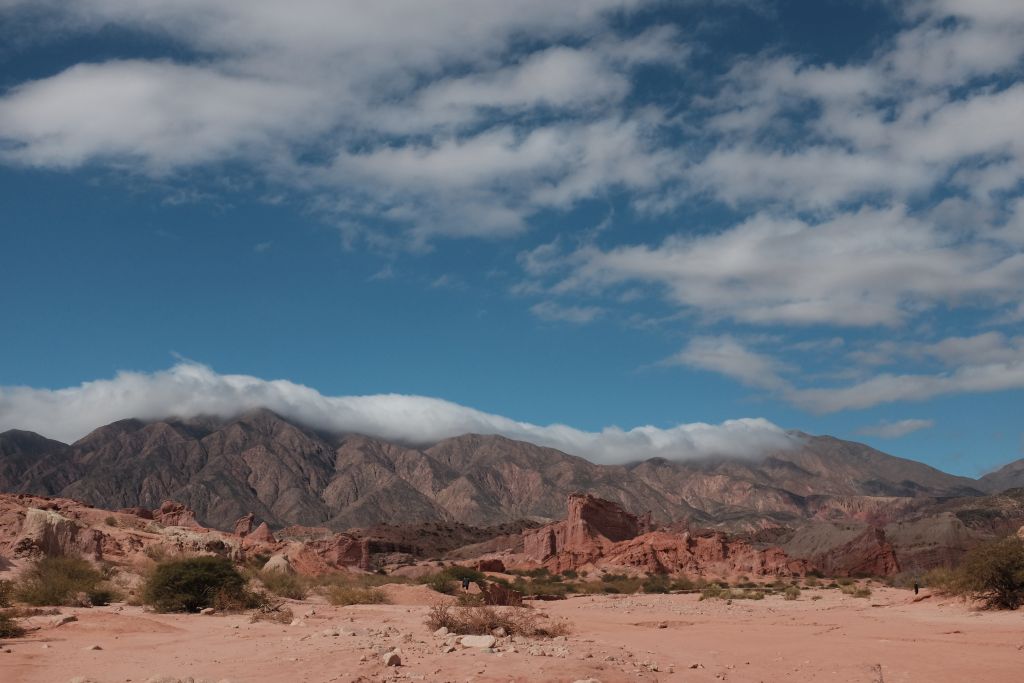
Riding around some cool rocks off the ruta 68 just outside of Cafayate
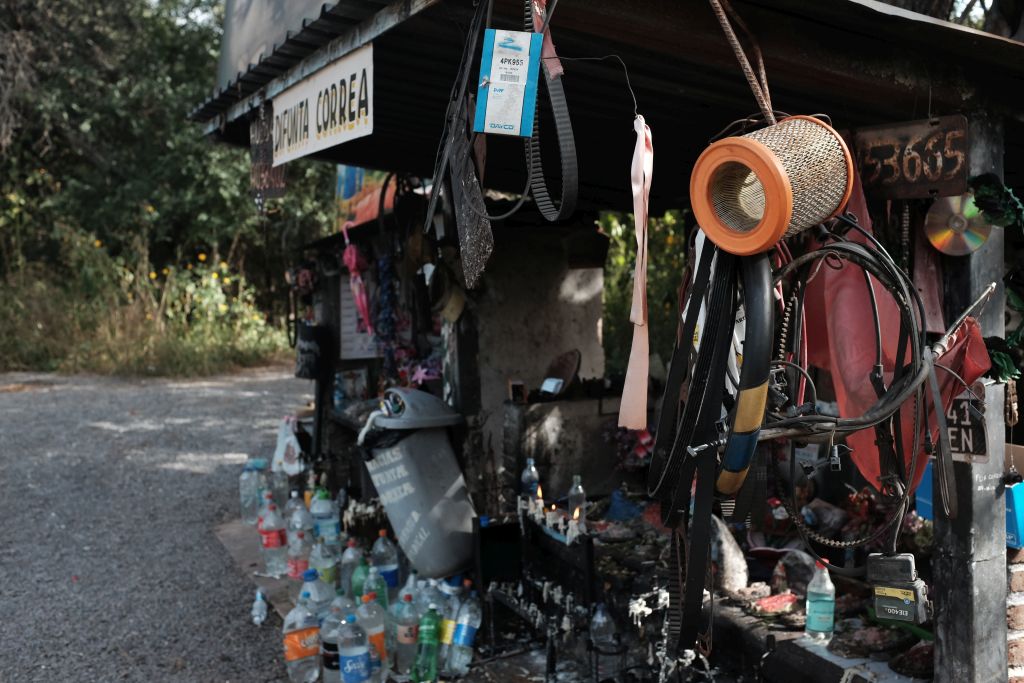
A Difunta Correa shrine with car part momentos
Having broken my glasses while riding on the ruta 40 I was determined to have some new ones made in Salta. We arrived early enough in the evening, which meant there were quite a few optometrists still open. I went to the nearest one where I found two kind, pleasant ladies working. The next 45 minutes was a bit of a hilariously fun whirlwind as I tried on nearly every pair of glasses in the store. I kept trying to communicate that I wanted a fun, colorful pair and I think they were generally a bit confused but intrigued by the tall bearded man in their shop. They measured my old pair for the prescription, I paid, and I was out the door; my glasses would be ready tomorrow. Afterward I went to meet Luca for dinner somewhere and while walking I came to find that this city is filled with optometrists and eyeglass shops. Turns out I was in and out in 45 minutes at the first shop I found. I liked the glasses, they were within budget, and ready tomorrow. No need to shop it around forever.

Top of Cerro San Bernardo in Salta Ciudad

Jujuy, my final Argentine province
Salta city was quite nice and rather large. We ate our share of Argentinian barbeque knowing that we were reaching the end. Plenty of empanadas and goat stews for starters. We rode out of the city and headed for the province of Jujuy where we had heard of some protests currently ongoing in which the demonstrators created roadblocks and only allowed traffic to pass for twenty-odd minutes every few hours. The road was clear to the city of San Salvador de Jujuy where we found a nice spot for lunch and enjoyed the town so much that we decided to stop cycling early and find a hostel. The road from here would be a constant and gradual climb to either the Chilean or Bolivian border so riding became slower than usual. In the town of Volcan, Argentina we had a quick roadside snack and a warm corn based drink called “api”. It was getting late so we decided to find a spot to camp in town. We asked the police who said we could camp on the square. Then we asked at the church where they said we could sleep under a portico roof outside. As we were setting up camp the pastor’s assistant came by and wondered why no one had let us inside. Eventually, we camped in a spare room at the church. It was a great campsite.

Sunny, dusty roads, the new normal

Church campsite
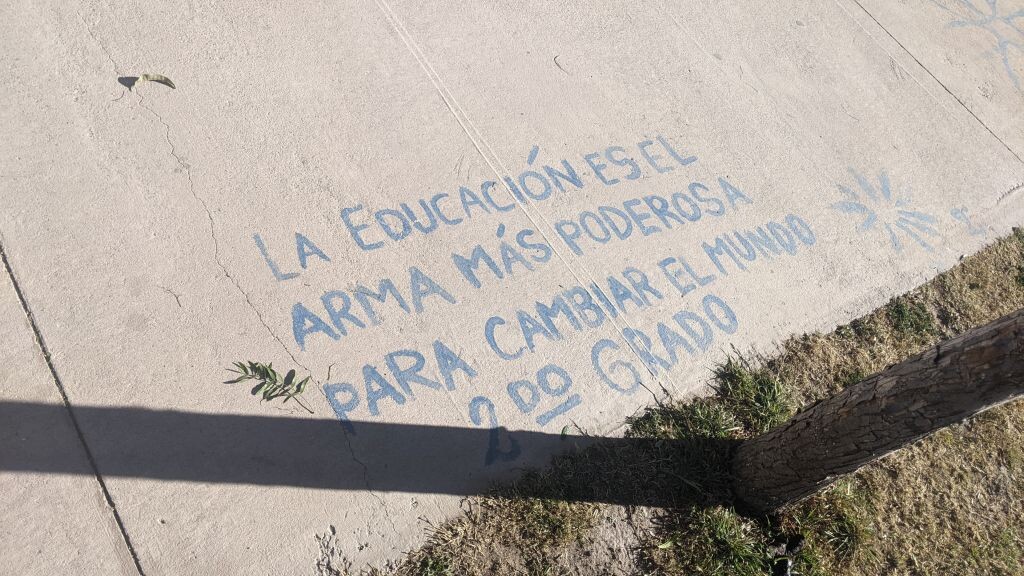
Education is important

Workers mural in Volcan
So far we had seen some small demonstrations here and there but encountered our first serious roadblock as we approached Purmamarca. The police had responded very heavy-handedly the night before our arrival and would continue to do so for the coming weeks leaving many protestors hospitalized in serious condition. We cycled past 10-15 kilometers of traffic before arriving at the roadblock itself where we found a calm, supportive atmosphere. We spoke briefly with a teacher who is protesting for higher wages because those in Jujuy province are some of the lowest in Argentina. After a brief conversation we continued on to the touristy town of Purmamarca where we ate a sandwich, rode through a cool and colorful canyon, and then parted ways. Luca would ride directly to the Argentinian-Bolivian border and I would head toward Chile one last time before entering Bolivia.
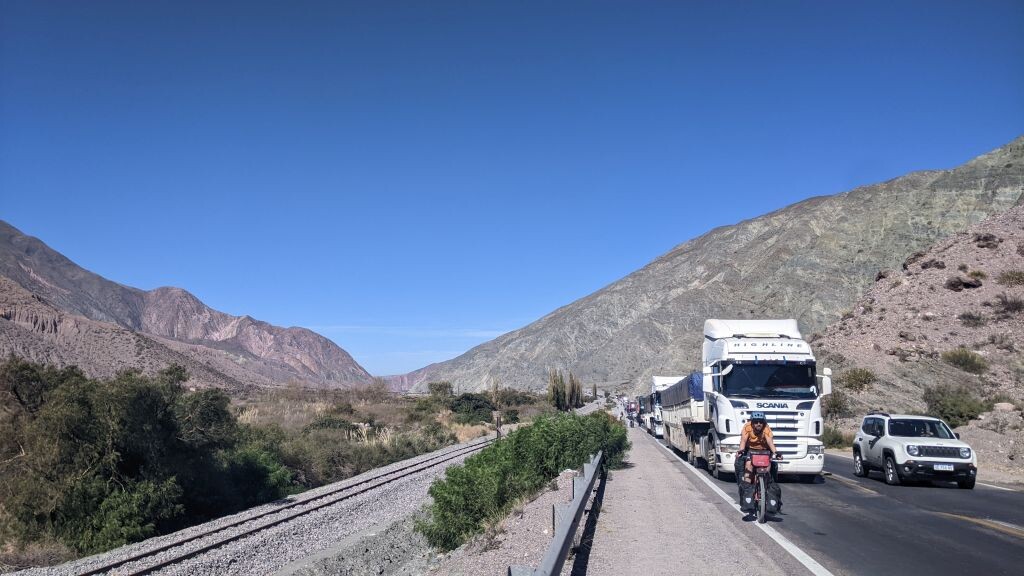
Biking past a long line of cars and trucks

Talking to a teacher who's protesting for higher wages
The road continued to climb out of Purmamarca and it was getting late, so I checked the map and aimed for a small town across the river called Puerta de Lipán. I only encountered about three people in the town and asked one of them if I could camp somewhere. On account of the teachers protesting the schools are closed so I camped under the covered playground of the schoolyard. As I was cooking dinner a man named Alejandro came and sat with me, he was incredibly interested in my MSR Whisperlite stove. He asked my how much it cost and I told him I didn’t know because it was a gift. Not a complete lie and not the whole truth. The following morning I thanked some people in town for their hospitality, filled my water bottles, and continued climbing. People were again quite enthusiastic to see some guy climbing this road on a bike, honking and waving as they went by. Eventually I made it to the top and rested there for about an hour in a feeble attempt to acclimatize to the altitude. I drank a mate tea and had my picture taken on the little monument.
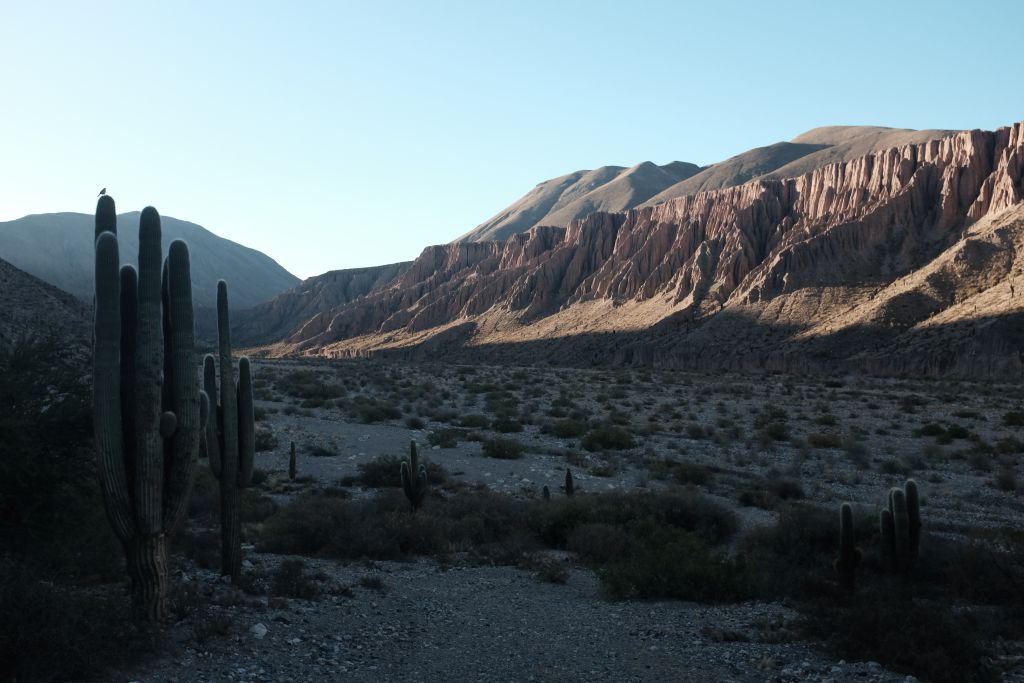
Cool landscape on the climb away from Purmamarca

Schools are all closed due to the protests; schoolyard campsite

We've seen it all before
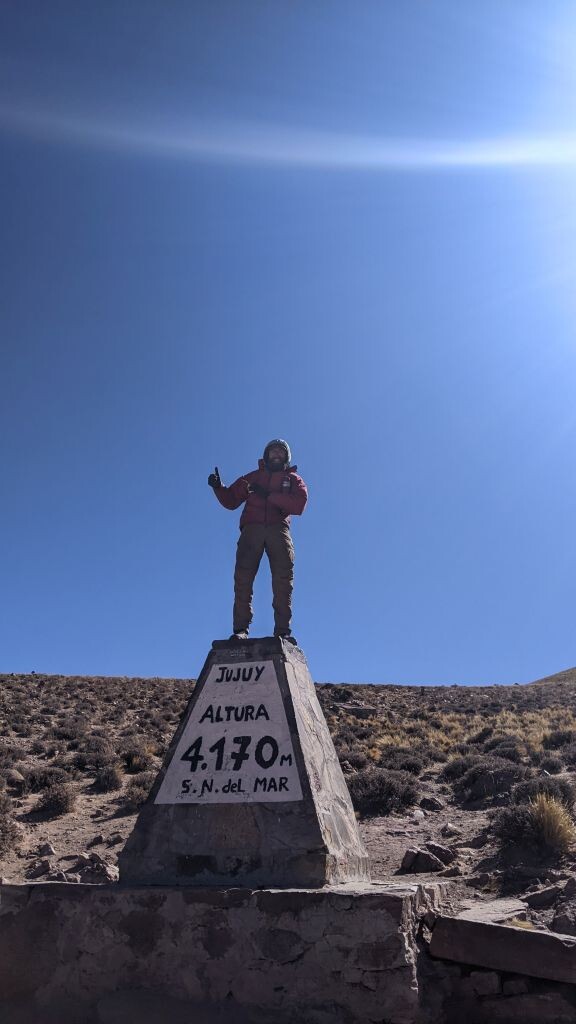
Up until now my highest pass, soon to be surpassed
From the top of the pass it was a fairly gentle, windy downhill onto the Salinas Grandes, the largest salt flats in Argentina. The descent was not as long as the climb and I now found myself on the “altiplano.” I stopped at a small restaurant to eat more empanadas and then continued on to the eerily quiet town of Santuario de Tres Pozos. There was very little going on but it was nice to be in a warm bed for the night because at this altitude it easily gets to -10° Celsius at night. The following morning I hit the road again riding on long, straight stretches with little traffic. Since the beginning of my trip in Ushuaia I had been carrying a full size spare tire, which may have been overkill. I had planned to ride my current rear tire until it simply wore through, which happened to occur on a lonely road in the middle of nowhere. I was quite excited to have something “go wrong” mechanically and got to work installing the replacement. I’ve struggled to mount a bicycle tire in a comfortable garage before but out there it was a completely different game. It took quite some effort and swearing and about three hours later I was cycling again.
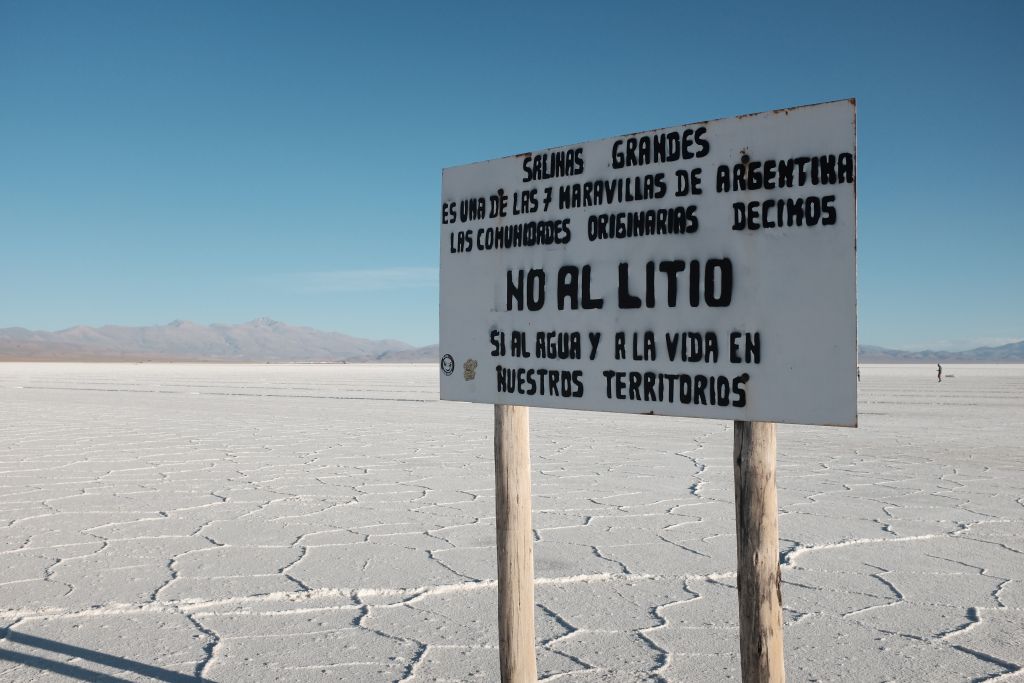
No to more lithium mines! Another point of contention
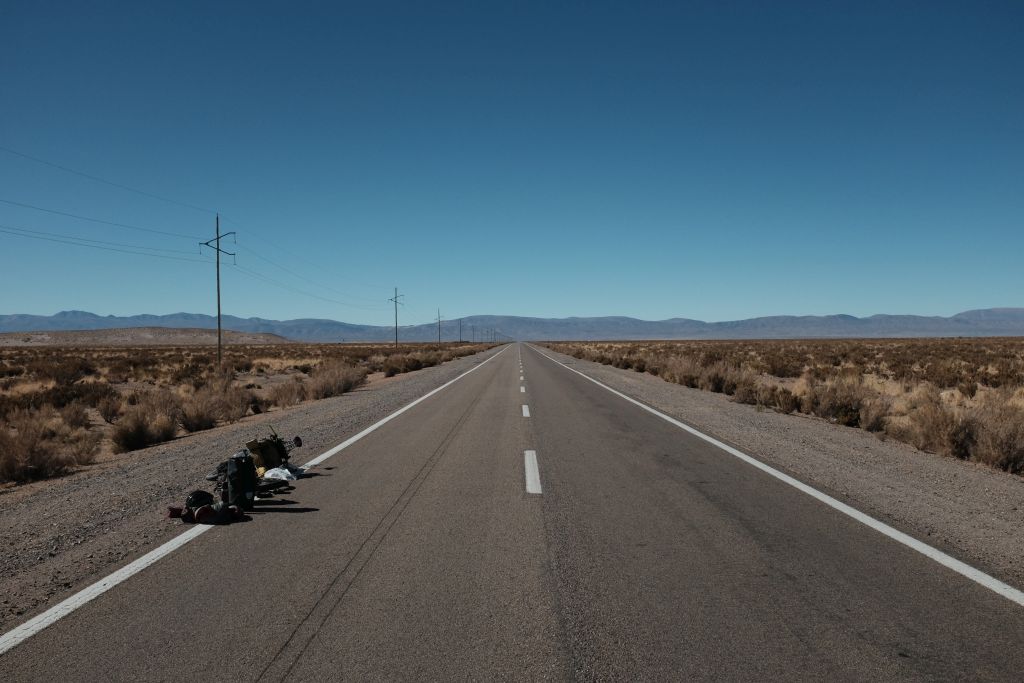
Changing my tire on the side of the road
I passed another roadblock, a rather small one this time, and asked if I could pass. The people there know that their struggle is not with me and were very friendly. Of course I could pass. They again offered me a cup of api, I gladly accepted and waited around for fifteen minutes and chatted in a weak attempt to show some solidarity. I rode past sunset into the dark knowing that the town of Susques would again offer me a cheap bed for the night. Upon reaching the outskirts of the town I encountered another roadblock, which was quite a bit bigger this time. The people there deliberated for half an hour or so before allowing me to carry on into town. Having had a long day of cycling, the following morning I took it easy and had a late start. I could’ve guessed, but the next morning was more uphill and this time with an annoyingly gentle headwind that kept progress at a walking pace. It took a while but eventually a truck stopped for me and could take me about 40 kilometers up the road. We lifted my bike into the back and I was told to just keep quiet when the truck stopped, the driver would tell me when I could come out. “Oh, and pass me that box of chicken.”
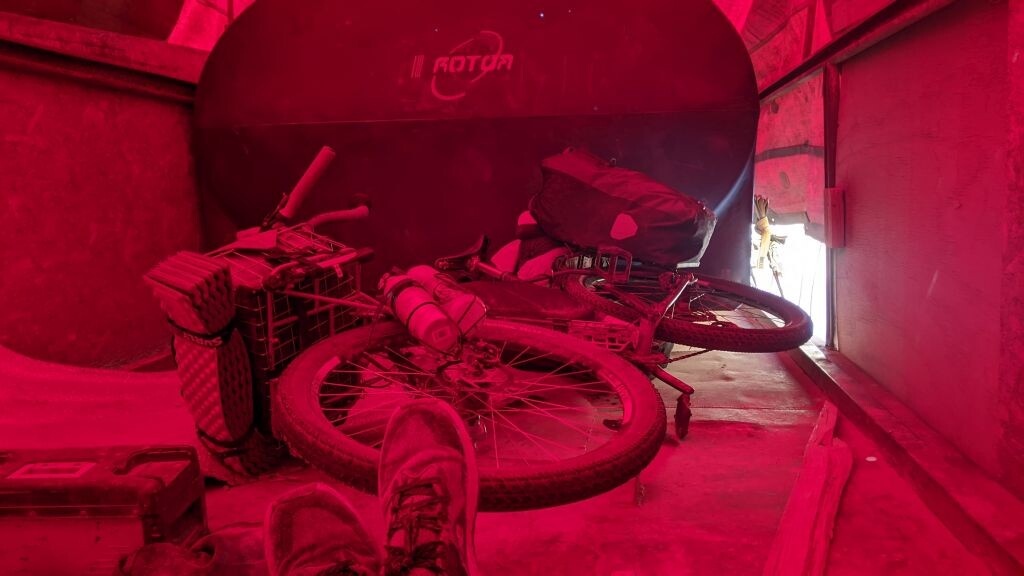
'Be quiet and just wait in the truck'
Eventually the truck stopped and I could hear some people rummaging about outside. After a few minutes some curious people started sticking their heads under the tarp and laughing. They must’ve caught wind of the cyclist in the back of the truck. I hopped out and found myself at yet another roadblock. The guys driving the truck were headed there to join the protest. I had made good progress with the truck but there was still a strong headwind and I didn’t really know what to do, whether to just start cycling or whether to wait here for a while. I heard someone say they needed hot water for tea so I took out my camping stove and set their massive pot on the boil. Shortly after that someone needed help starting the barbecue, which a bit of camping fuel made short work of. I then spent the rest of the afternoon, every once in a while, scouring the barren ground nearby for firewood. I had somehow ingrained myself into the group. I was told I could carry on cycling or I could stay until the evening when another truck, which could easily take me and my bike, would head for the border. I decided to stay for the afternoon.

Another long line of buses and trucks at a roadblock

Firing up the grill at the roadblock
I spent the rest of the day at the roadblock helping with little things here and there. Two young kids took an interest in me and my bike and we spent most of the day chatting with my broken Spanish and some Google Translate. I let them ride my bike around the place and they let me shoot at road signs with their slingshots. They asked me how much my bike costs and I lied again. After a nice dinner of chicken and rice the sun had set and the roadblock packed up ready to resume again tomorrow. I tossed my bike in the back of a big truck and got ready to go. I sat patiently in the passenger’s seat as I gathered that, in that very moment, the driver was being instructed on the operation of a semi-truck transmission. Eventually we got rolling but never went faster than 20 kilometers per hour. It was a little awkward as the young driver never seemed to be able to get the truck into third gear. Somehow I saw this moment as a metaphor for Argentina: a country of incredibly generous, friendly, and curious people that had always been ready to help me, feed me, or encourage me but like this truck, powerful and capable in the right hands often unable to find the right gear.
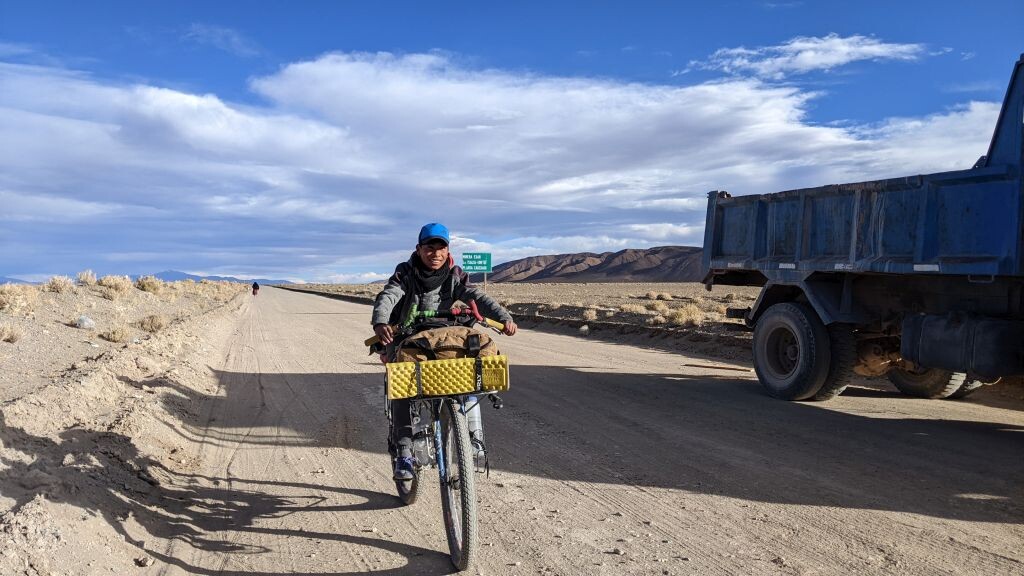
Little guy making it look easy
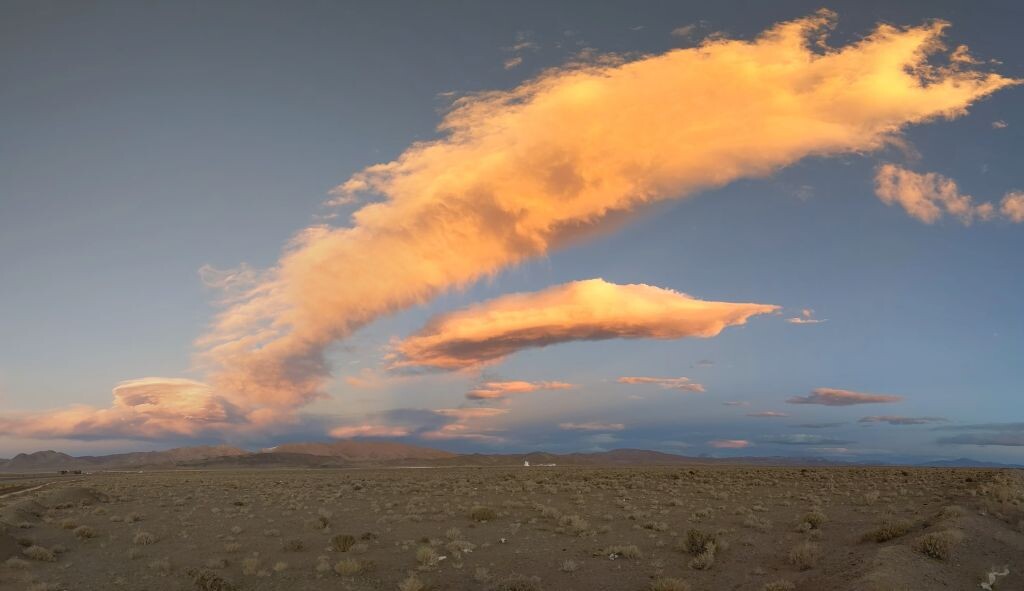
Nice sky at sunset
The protests in Jujuy province would carry on for several more weeks as the people fought against constitutional reforms that would limit their rights. Some people spoke of other factors like worker pay and the prospect of more mineral mining. The area is rich in sodium, potassium, and lithium but the wealth that they provide is not shared widely with the community. Many cars, buses, and trucks once allowed to pass the roadblock would honk and shout words of encouragement, “¡suerte, solidaridad!” But I couldn’t shake the feeling that the people living here are being forced into a global economy, one that will go on to make incredibly valuable products out of the minerals mined here, and that those waiting in the cars and trucks were passing the time on their smartphones, which more than likely started their journey here as raw materials high on the altiplano. After so many layers of abstraction I feel disconnected from the causes of the protests and the people who may not even want to participate in the global economy but have no choice. This final protest took place at an intersection leading to two large lithium mines. When I asked the young kids what becomes of the lithium, I was happy to hear them reply “it goes to China to make batteries!”
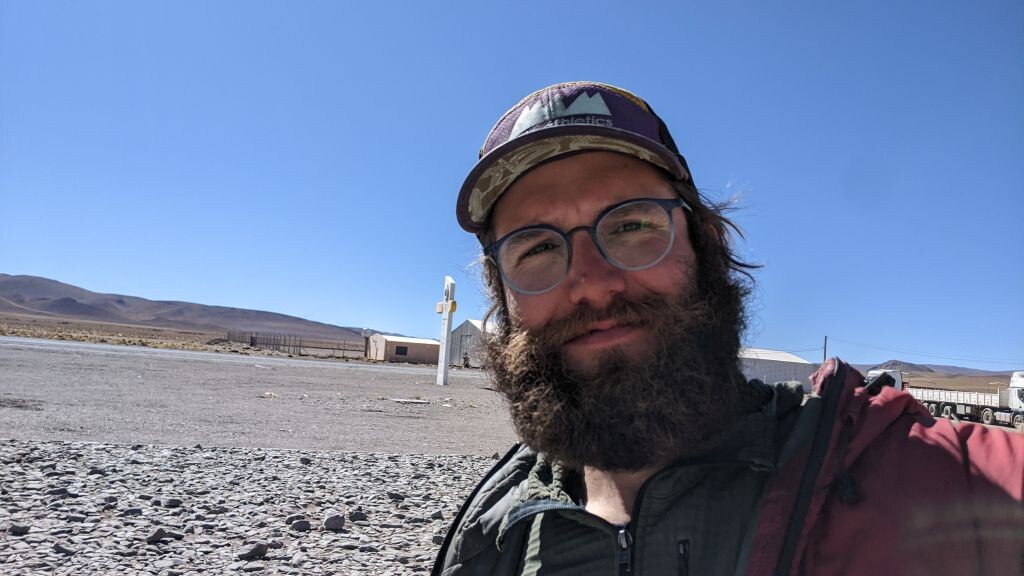
Your intrepid cycling hero with his new glasses
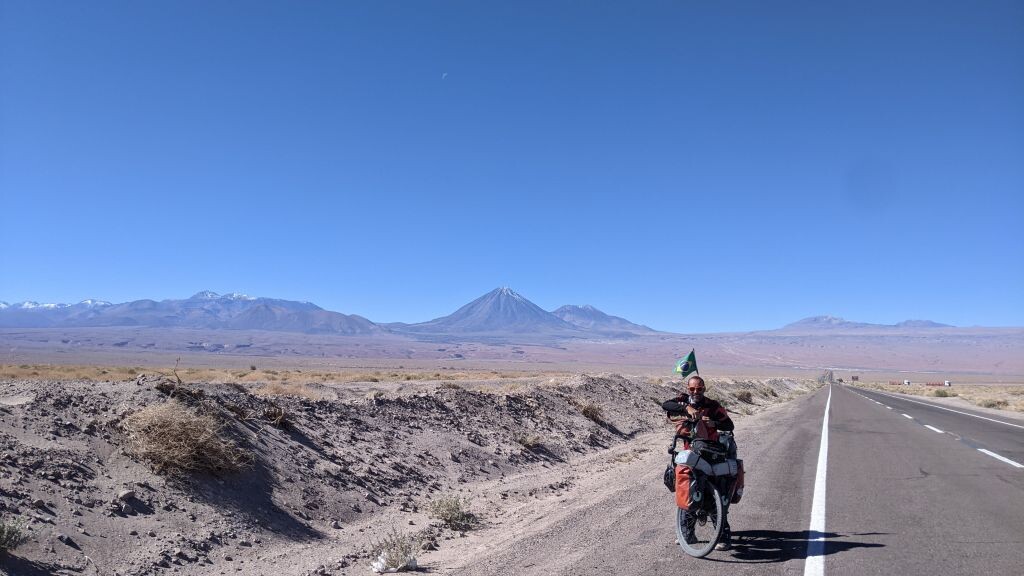
Keke and I arriving in San Pedro de Atacama
Eventually our truck made it to Jama and the Argentinian-Chilean border. I got in late and went to the first hospedaje I found in town. The driver of the truck told me to come sleep at his place if the hospedaje was closed. The following morning I crossed into Chile, ready to cycle to San Pedro de Atacama across a long, barren stretch of high desert. About an hour into the climb I met Keke, a Brazilian cyclist who had the same plan as me but had left a day earlier. He spent the night up high and had his tent ripped by the wind. He was returning to the town of Jama in Argentina to try and hitch a ride; he encouraged me to join him and do the same. After some deliberation I rode back to Jama as well. We spent the following day at the YPF gas station in town asking trucks with visibly empty trailers if we could ride with them to San Pedro de Atacama, Chile. “Sure, of course!” they all said, but first they’d need diesel and the gas station was fresh out. The truck that would resupply the station with diesel was also stuck at the roadblocks that had now become stricter allowing very few cars to pass. In total I’d spend three nights in the small town of Jama at the border, but eventually the YPF diesel truck came one night, refilled the station, and we were riding into Chile the next day.

Valle de la Luna hike
I spent one whole week resting in the touristy town of San Pedro de Atacama, Chile. There I once again met up with two Austrian cyclists, Marlen and Ferdi that I had met several weeks earlier in Cafayate, Argentina. There I also met Dan a fellow cyclist from the UK. We’d carry on together from here into Bolivia, to the lagunas route, which promised to be a difficult and remote stretch. We went hiking and cycling one day in the Valle de la Luna but otherwise spent our time eating, reading, and having some beers. San Pedro lies relatively low at around 2,400 meters and returning to the Bolivian border, an intersection we had already passed, meant climbing more than 2,000 vertical meters over the course of some 40 kilometers. We obviously decided to hitchhike but had no luck on day one, probably on account of the late start. As we rode back into town I chatted with some tour-operators and arranged for a van to take us the following day for a reasonable price. The following morning, I messaged the driver as we rode to the agreed-upon meeting point but he had taken another job last minute, “sorry.” I saw a vehicle-carrier truck and went over and chatted with the driver. I asked if he could take four people and four bikes. He said it was no problem, “just let me finish my lunch and wait over there.” Eventually he rode over and introduced himself, Oscar Daniel was his name. The truck was loaded up with used cars from Japan headed for Paraguay. We loaded our bikes into the voids between the cars. Marlen and Ferdi road up front in the cab with Oscar Daniel while Dan and I rode in a sedan on the vehicle carrier. Once we reached the top of the “hill” we promptly offloaded the bikes, took a few pictures together to remember the fun experience, and Oscar Daniel gave us several bags of food and coca as gifts. I tried giving him some chocolate bars in return but he refused everything but a small alfajor. I continue to be impressed on a daily basis by people’s generosity and willingness to help strangers.

Dan no-hands

Waiting for a ride
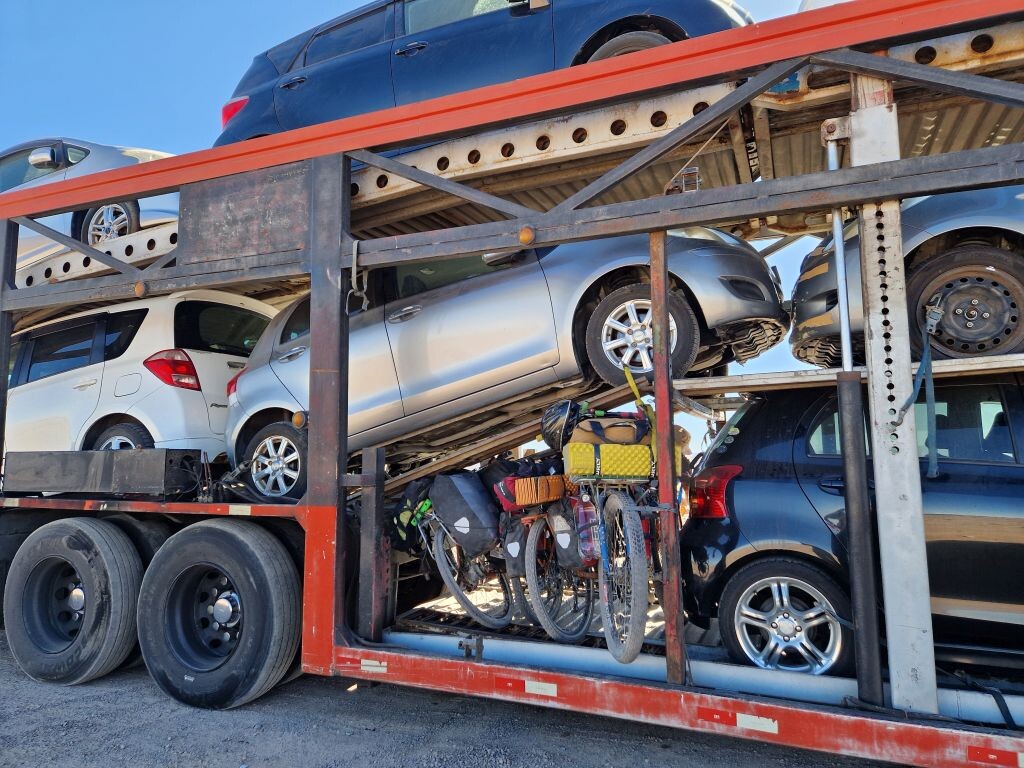
The bikes loaded up, ready for the climb

Dan and I on the vehicle-carrier
The lagunas route: A character building experience
After much anticipation I had finally entered Bolivia. Our plan was to cycle from the Hito Cajón border crossing along the lagunas route to the Salar de Uyuni. It was a stretch I had looked forward to for a long time. I spent many hours looking at this section of the map. What would it be like? It looks pretty rugged, like something I’ve never seen before. It promised to be a very dry climate, with nighttime temperatures hovering around -15° Celsius. We’d spend the next week climbing and descending from about 4,400 to just under 5,000 meters. To top it all off, the “road” surface is mostly loose sand with rocks. I’m glad I spent my time looking at the map and inspecting the route from a superficial vantage point. I’m glad I saw the option, thought it looked cool, and jumped right in. I’m not sure I’d ride this section again knowing what I know now.

Finally entering Bolivia
The day we crossed the border, we slept within the walls of a ruined house. It offered ample wind protection and a great view of the first of many salt lakes that dot the high-desert region. In my mind, it’s difficult to parse many of the finer details of my days on the lagunas route. There’s simply a daily pattern to be followed of waking up, trying to eat some breakfast, climbing, maybe descending, and covering 30-40 kilometers in a long ten hour day. The days begin to run into each other and you just try to remember to enjoy the scenery for its absolute otherworldly-ness and to drink lots of water.
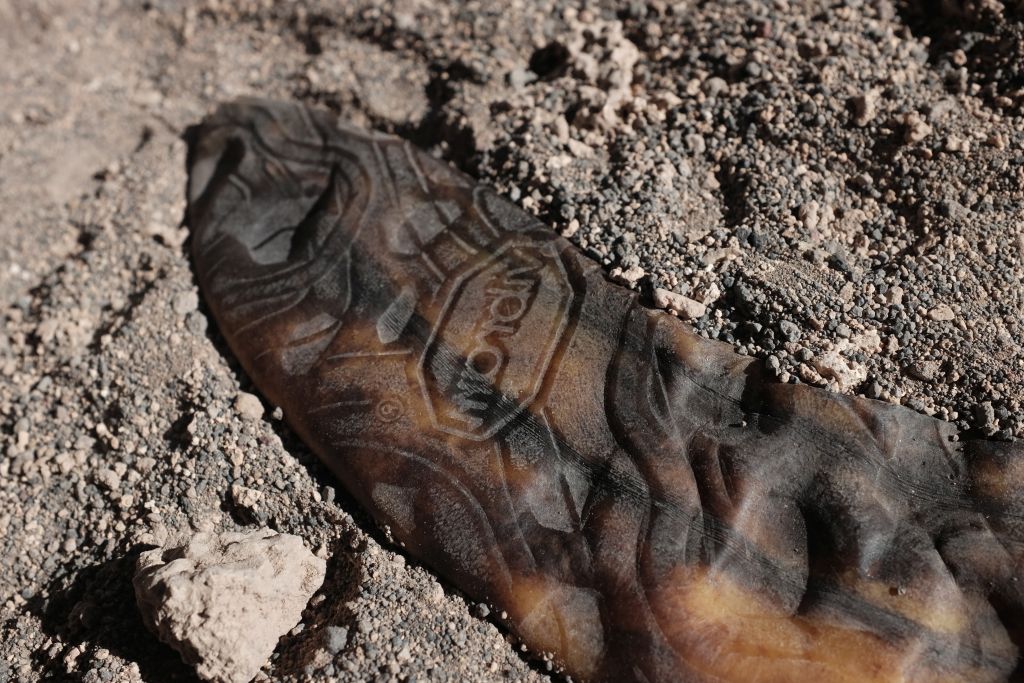
I stepped on my banana
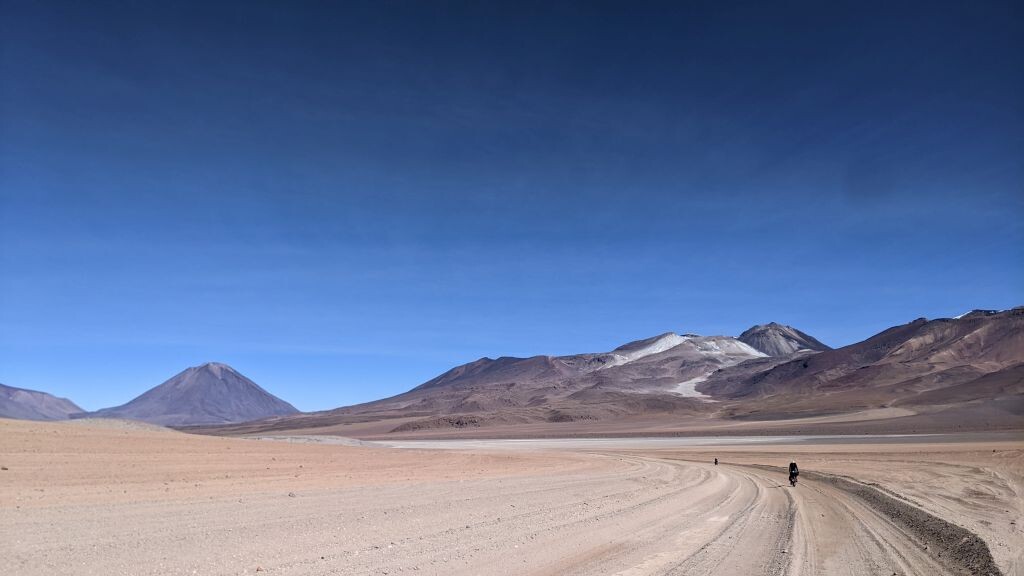
Marlen and Ferdi on one of many lagunas route climbs
After our first full day on the route we reached the small town of Chalviri with enough time to enjoy the hot springs. Normally, at home, I’m a fan of a good workout, a nice sauna session, and then a big dinner. Why couldn’t we do the same here? I felt exhausted after 30 minutes in the pool but afterwards we made a nice dinner together and some kind folks allowed us to sleep in a dormitory for road workers because on Sunday it was empty anyways. The next morning I woke up feeling absolutely terrible with what felt like an awful hangover. I couldn’t manage to eat any breakfast, felt nauseous like I wanted to throw up, and had a screaming headache. My guess is that with the altitude my body was unable to recover from the stress and strain caused by the hot springs. Let’s go cycle in some sand!

Hangin' out 1

Hangin' out 2
Everyone in our little group of four would have a tough day and today was mine. I lagged behind for most of the day and questioned my decisions. With all the time in the world to think your day seems to be never ending. Your wheels spin in the sand, your gasping for air at nearly 5,000 meters altitude, the muscles in your legs are protesting, and you curse whichever silly, stupid European cycle-tourist came up with this ridiculously contrived route. It’s a Tuesday afternoon and you wonder what it would’ve been like in the office today. I often thought back to the Serbian shores of the Danube and a trip nearly two years ago that firmly established my interest in cycle touring. I thought, take me back to the gentle hills, the equally friendly folks, and the smooth roads with towns every 20 kilometers serving fresh coffee and burek sir. Before leaving on my trip I scribbled some inspirational quotes in my journal and thought back to one by the Persian poet Hafez, “there is no road to which there is no end, do not despair.”

Sandy roads and neat rocks

Starting to feel better, rallying the troops ¡Viva la Revolución!
Late on that second day we arrived at a small hospedaje in the town of Huayajara. I woke up the following morning and before moving my head, I scanned the room with my eyes, trying to inspect how I felt, maybe like you’d do after a night of beers with friends. To my surprise I felt fantastic! We took a rest day there and spent the day gathered around a table in the warm dining room drinking tea, playing cards, and reading or writing. This day I was amazed at how good I felt, still a little out of breath, but much better than the day before. I tried to contain myself a bit, to not show off my newfound upswing in physical state, as today it was someone else’s turn to feel the wrath of altitude.
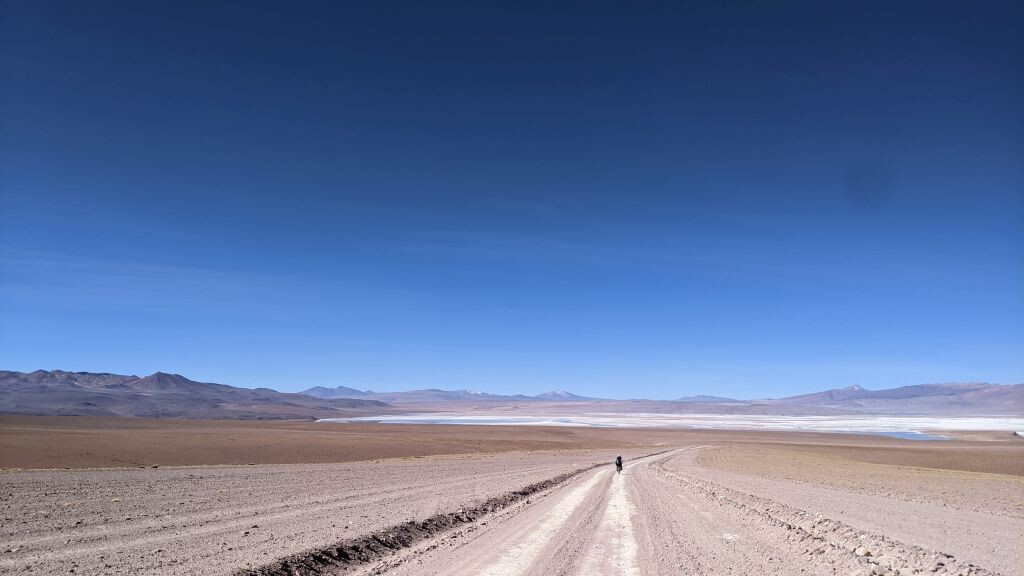
Climbing away from another salt lake
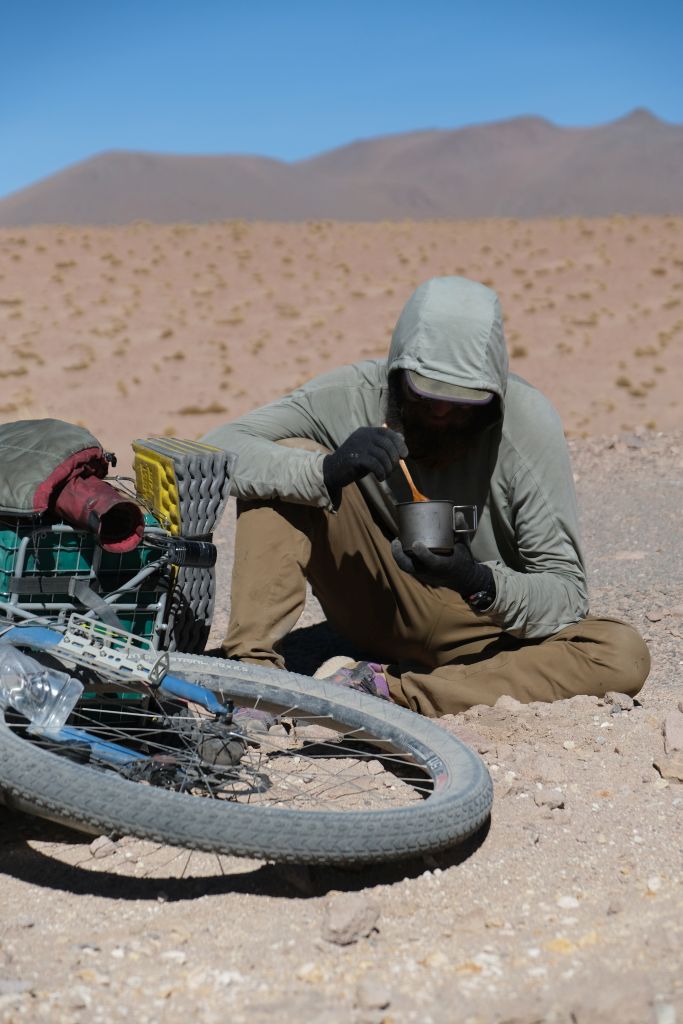
Feeling rough. Trying to get a little food down for lunch

A long march up a long hill
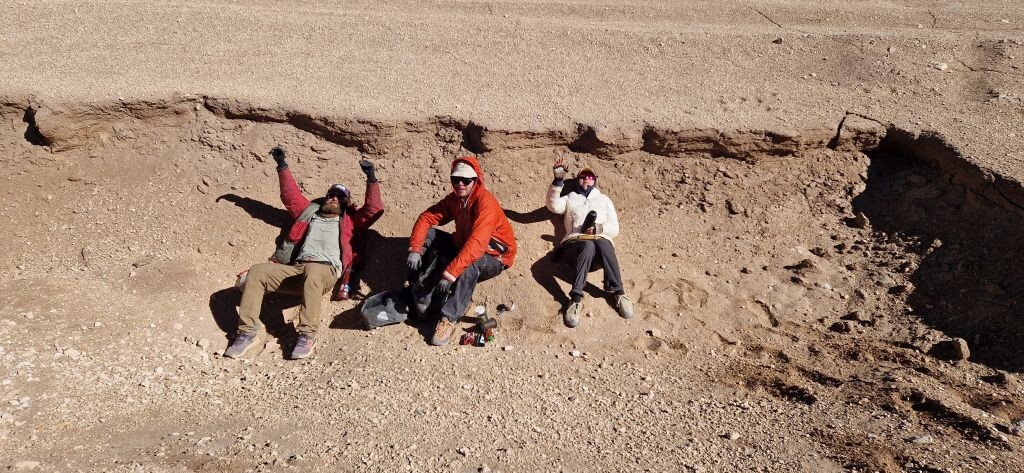
A nice ditch for lunch, 'Raise your hands if you're still alive'
I’m very happy to have cycled the lagunas route as part of a small group. It made the experience much more enjoyable when we could all laugh off the sufferfest which we had all decided was a good idea. The cycling was very difficult and if my favorite parts of the trip have been talking to people and learning Spanish then this route offered none of that; instead it was like cycling on the moon, also low in oxygen, but without the benefits of reduced gravity. I would categorize the lagunas route very decidedly as type 2 fun and I think the years will be kind to my memories of a week spent in a place that’s too high, too cold, and too dry all the while laughing it off with friends.

Dan walking through the town of Huayajara

The world's collection of classic Toyota Land Cruisers is here in southwestern Bolivia. I think I saw a Nissan once. Everything is Toyota.
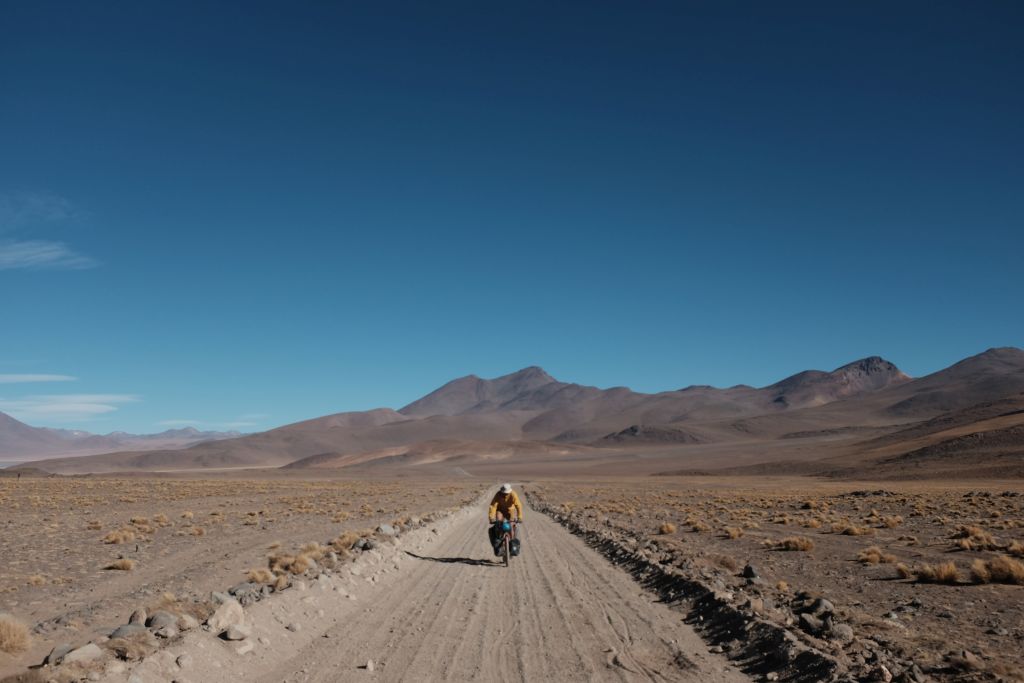
Dan out for a bike ride

The gang waits on a truck to pass; taking a breather before the dust arrives

Dan climbing some rocks
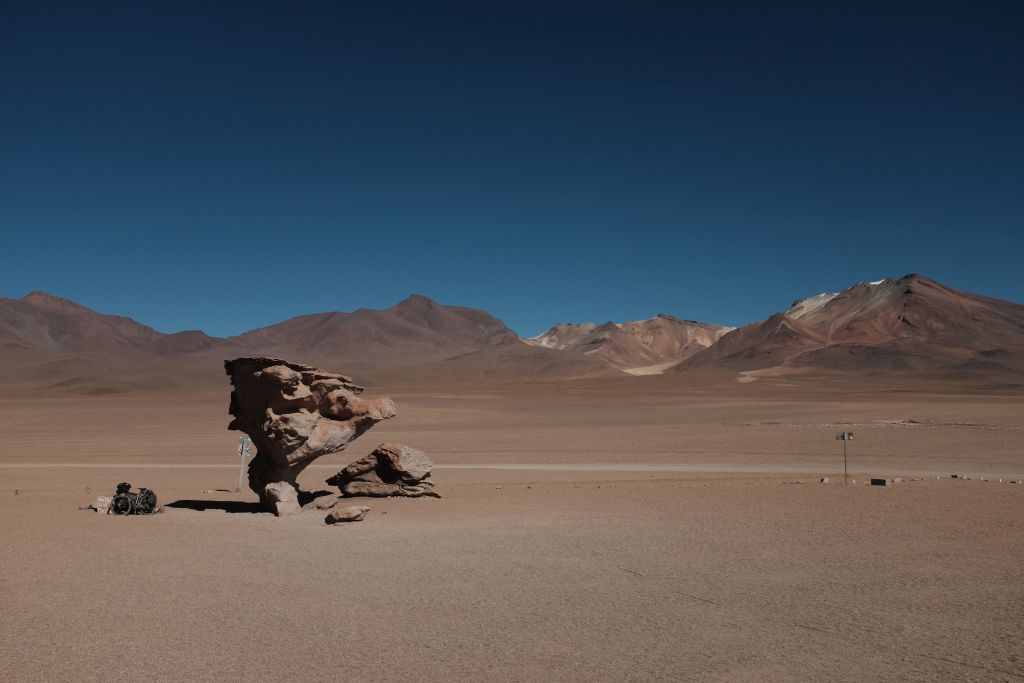
Piedra de Arbol

Tough, sandy roads
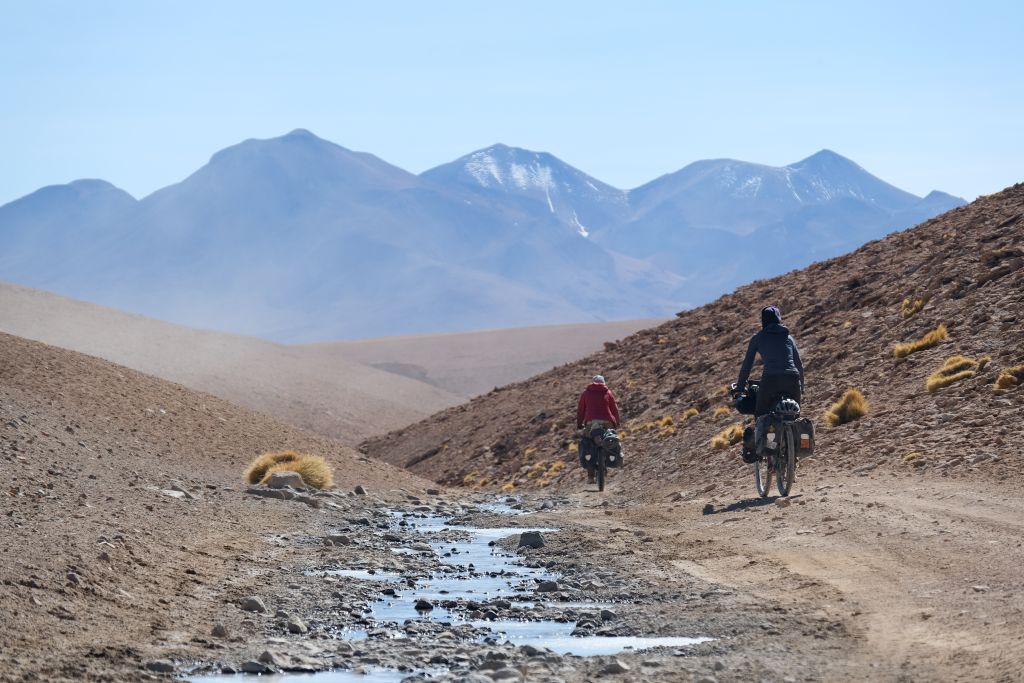
A nice downhill canyon

Sleeping flamingos
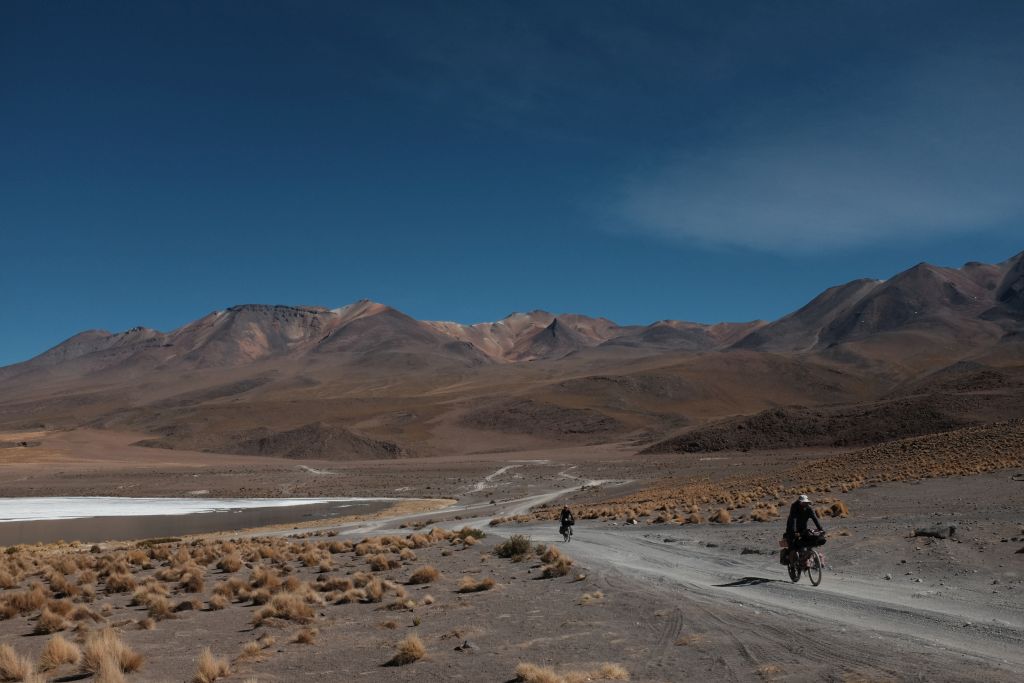
Marlen and Ferdi on yet another sandy climb

The never ending lagunas route
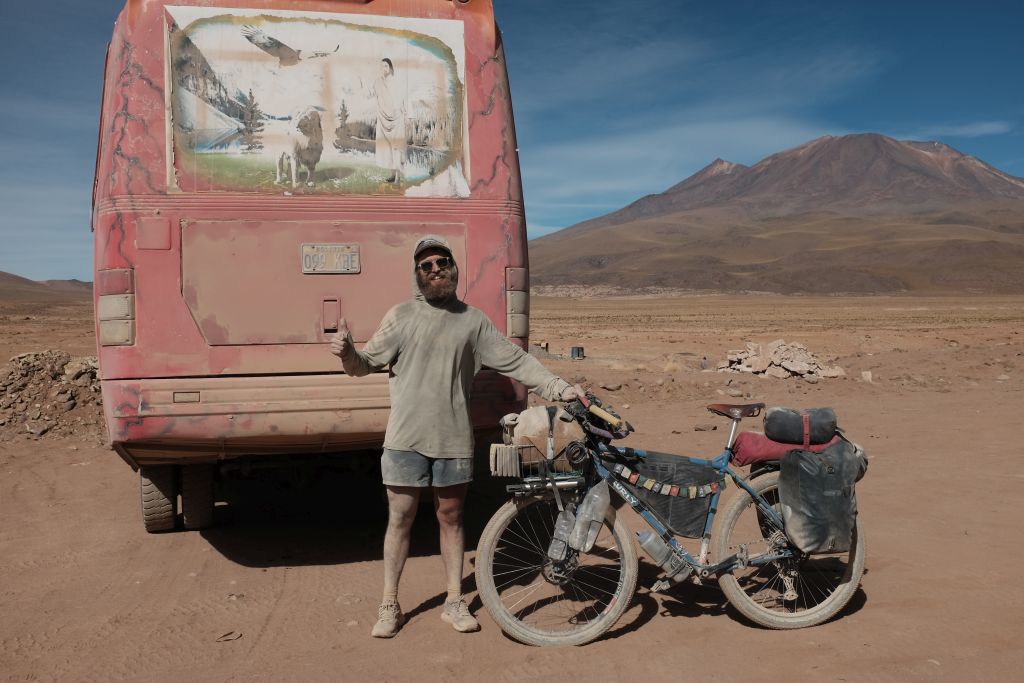
I fell a few hundred meters before the end of the lagunas route. An unceremonious end. No sign, just a mural on a bus

Lagunas route tea break, a little dusty
Eventually the lagunas route did come to an end as we reached the small town of San Juan, Bolivia. From here it would be one more day of cycling until reaching the Salar de Uyuni, the largest salt flat in the world. Shortly before reaching the salt flat I decided to hang back and separate from the group because I wanted to cycle across and camp solo on the Salar. I had looked forward to this moment for the entire trip and it absolutely did not disappoint. Taking in such a vast expanse of space, seeing the colors change with the changing light, sleeping simply in my sleeping bag, sheltered behind my bike in the night while looking up at the sky, it met my highest expectations and once again gave me that feeling of “Yes! I’ve done it and I’m out here!” Our little group was partially reunited on the eastern end of the Salar and together we rode into the town of Uyuni. In town we are staying at a “Casa de Ciclistas,” which is a simple, donation based accommodation for cyclists. The bike got a good cleaning to remove the sand and salt, I posted the long overdue update that you’re reading now, we went out for very good pizzas, and I took some time to hang in a hammock and read. Having passed such a huge milestone for myself, the Salar de Uyuni, the road ahead begins to take shape as I hear of other neat and interesting places to visit. Sunday we’ll take off in the direction of Potosi and Sucre. I’m feeling really good and happy to be out here!

Waiting on the lithium train
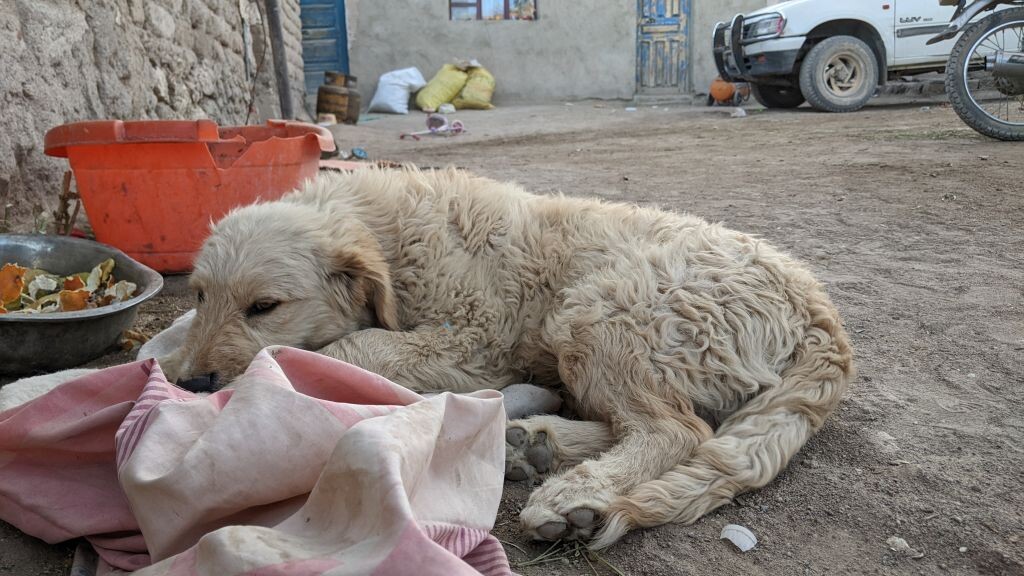
Cute dog overload

Sunset on the Salar de Uyuni

Prayer flags showing a nice tailwind for tomorrow
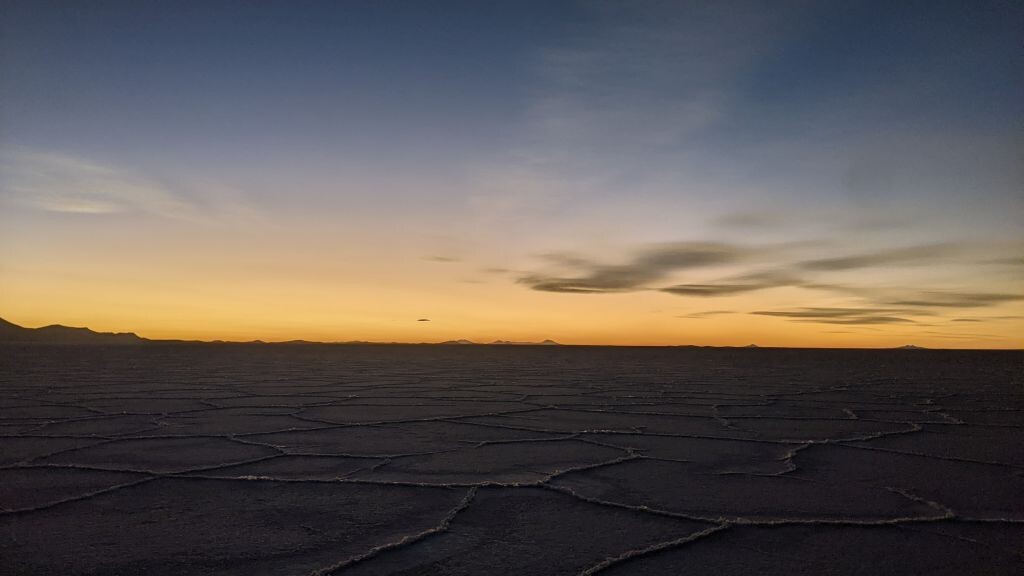
Sunset from my campsite on the Salar de Uyuni

Sunrise on the Salar
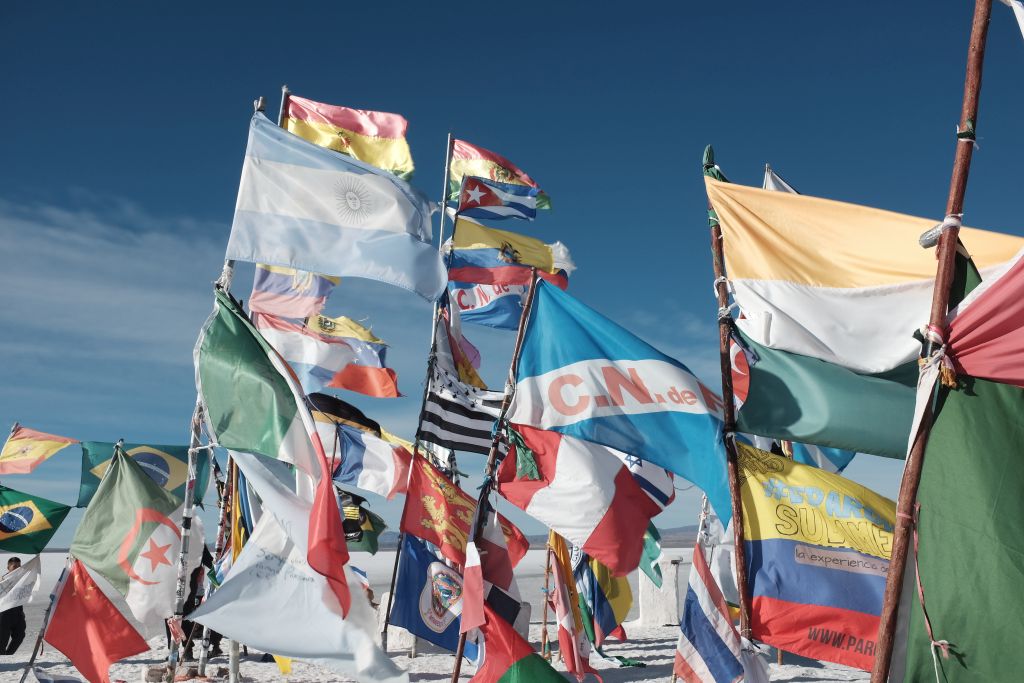
The Isla de Banderas at the eastern end of the Salar; just a few more kilometers to some rest days in Uyuni

Riding into the town of Uyuni